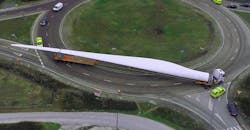GE Produces First Recyclable Wind Turbine Blade
GE Renewable Energy reported progress in the development of recyclable wind turbine blades – an effort underway by a consortium of which GE is part. The first prototype, 100% recyclable blade is a 62-m long structure produced in thermoplastic resin embedded with a high-performance glass fabric material.
The ZEBRA (Zero wastE Blade ReseArch) consortium project also involves specialty material developer Arkema and high-performance fabric developer Owens Corning, and rotor-blade manufacturer LM Wind Power, a GE Renewable Energy business. The research is led by a French industrial research center, IRT Jules Verne.
Other members of the consortium are CANOE, a specialist in polymer formulation and fiber-reinforced composite manufacturing; Engie, a renewable energy supplier; and SUEZ, a provider of environmental services.
The liquid thermoplastic resin is adapted for manufacturing of large parts by resin infusion, combined with high-performance fabrics. The resulting composite material reportedly performs similarly to thermoset resins – but is recyclable.
LM Wind Power designed and built the blade at its plant in Ponferrada, Spain, following a year of material development and testing, and sub-component process trials by the consortium partners.
The composite components can be recycled using an advanced chemical recycling method during which the resin is fully depolymerized, fiber is separated from the resin, and new virgin resin and high-modulus glass are separated, ready for reuse.
“With this project we are addressing two crucial industry challenges. On one hand, we are progressing on our Zero Waste Blades vision by preventing and recycling manufacturing waste. On the other, we are taking blade recyclability to a new level: the end-of-life thermoplastic composite blade material has high value in itself and can be readily utilized in other industries as material compounds but can also be depolymerized and the resin reused in the production of new blades,” stated John Korsgaard, LM Wind Power senior director.
In addition to material testing and process trials, the consortium also reports progress on developing and optimizing the manufacturing process, using automation to reduce energy consumption and production waste.
LM Wind Power will now start full-scale structural lifetime testing at its Test and Validation Centre in Denmark, to verify the performance of the composite material and its feasibility for future sustainable blade production. Once these tests are finished, end-of-life recycling methods will also be validated.
